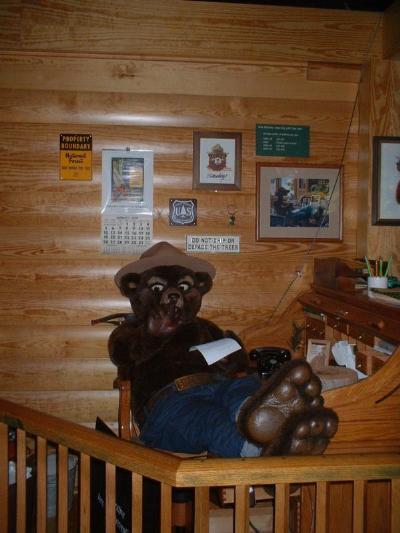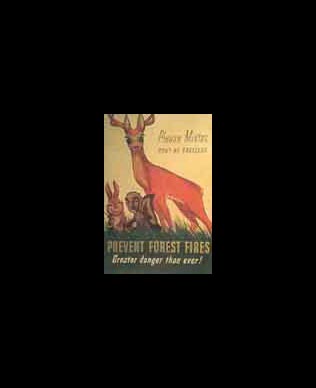National Mascots – Smokey Bear
Hours are the same as all Minneapolis Parks 6:00 AM to
10:00
PM.
Smokey facts from a Smokey Fan
Smokey Bear is the only cartoon chararcter to have his own
zip
code(20252) as well as his own Washington D.C. office.

Smokey Bear came about because of Japanese attacks upon
the
nations Western forests, a vital war supply. These attacks
came
from submarine but mostly by balloons carrying an incendiary
device
that would drop upon reaching mainland.

Smokey Bear was not the first poster child of Forest Fire
prevention, the first may have been the evil character on
horseback
spreading fire through the woods, then came the German and
Japanese
war characters, then Bambi was loaned for one year from Walt
Disney
for the war project. Unfortunately or fortunately Bambi was
to
remain a Disney product and the search was made for a
National
Spokesman that would forever remain in their employ.

His name is Smokey Bear, the name “Smokey the Bear” was
created
by a songwriting team, either to evade licensing or perhaps to
make
the lyrics fit the melody. He was never called Hot Foot
Teddie
although the first rescued bear cub that became the Smokey Bear
zoo
animal was.
Smokey Bear's message "Only You Can Prevent Forest Fires"
was
created in 1944 by the Ad Council. In a recent study, 95% of
those
surveyed could finish the sentence when given the first words.
In
April 2001, Smokey's message was updated to "Only You Can
Prevent
Wildfires."
The rules for appearing as Smokey Bear.
- 1. Use the costume only to further public information,
education, and aware-ness of the prevention of wildfires.
- 2. NOT TO SPEAK during appearances. Conversations or
explanations should be carried out by the accompanying
official
(escort).
- 3. Never appear in less than full costume.
- 4. Remain anonymous at every appearance and in any
publicity
connected with an appearance. This includes being
photographed
without the head.
- 5. Use only costumes that are clean, complete, and in
good
condition.
- 6. Keep costume out-of-sight before and after use.
- 7. Appear dignified and friendly. Avoid clowning and
horseplay.
- 8. Always be accompanied by an appropriately uniformed
escort
in public appearances, except where not practical, such as on
a
parade float where space is limited.
- 9. Refrain from using alcohol or drugs prior to and during
the
Smokey Bear appearance. This condition applies to officials
as
well.
Upon his death the original Smokey Bear was buried in the
Capitan, NM National Forest. Smokey II like his predecessor was
a
cub rescued from a forest fire although when Smokey II died
the
Forest Service was unsure if they wanted a row of sequential
Smokey
plaques so instead they burned his carcass.

Smokey Bear – The official story
Created in 1944, the Smokey Bear campaign is the longest
running
public service campaign in US History. Smokey's forest fire
prevention message remained unchanged for 50 years until
April
2001, when the Ad Council updated his message to address the
increasing number of wildfires in the nation's wildlands. As one
of
the world's most recognizable fictional characters,
Did you know the cartoon Smokey Bear is based upon an
actual
baby black bear that was found alone, charred, and scared after
a
devastating wildfire burned through New Mexico?
One spring day in 1950 in the Capitan Mountains of New
Mexico,
an operator in one of the fire towers to the north of the
Capitans
spotted smoke and called the location into the nearest ranger
station. The first crew discovered a major fire being swept
along
the ground between the trees, driven by a strong wind. Word
spread
rapidly and more crews reported to help. Forest Rangers, army
soldiers, men from the New Mexico State Game Department, and
civilian volunteers worked together to gain control of the
raging
fire. As soon as they contained the fire to one spot, the
wind
would push it across the lines. During one of the lulls in
firefighting, a report of a lonely bear cub who had been seen
wandering near the fireline was reported. The men left him
alone
because they thought the mother bear might come for him.
Several soldiers were caught directly in the path of the
fire
storm, barely escaping by laying face down on a rockslide for
over
an hour until the fire had burned past them. In spite of the
experience, the firefighters were safe except for a few
scorches
and some burned holes in their Nearby, the little cub had
been
caught in the path of the same fire and had not fared as well.
He
had taken refuge in a tree that was now nothing but a charred
smoking snag. His climb had saved his life but left him badly
burned on the paws and hind legs. The soldiers removed the
little
bear cub from the burned tree, but they did not know what to
do
with him. A rancher, who had been helping the firefighters,
agreed
to take the cub home. A New Mexico Department of Game and
Fish
Ranger heard about the cub when he returned to the fire camp
and
drove to the rancher's home to get the bear. The cub needed
veterinary aid and was flown in a small plane to Santa Fe where
the
burns were treated and bandaged.
The news about the little bear spread swiftly throughout
New
Mexico. Soon the United Press and Associated Press picked up
the
story and broadcast it nationwide. Many people wrote or called
to
inquire about the little bear's progress. The State Game
Warden
wrote an official letter to the Chief of the Forest Service,
presenting the cub to the agency with the understanding that
the
small bear would be dedicated to a publicity program of fire
prevention and conservation. The go-ahead was given to send
the
bear to Washington, DC, where he found a home at the National
Zoo,
becoming the living symbol of Smokey Bear.